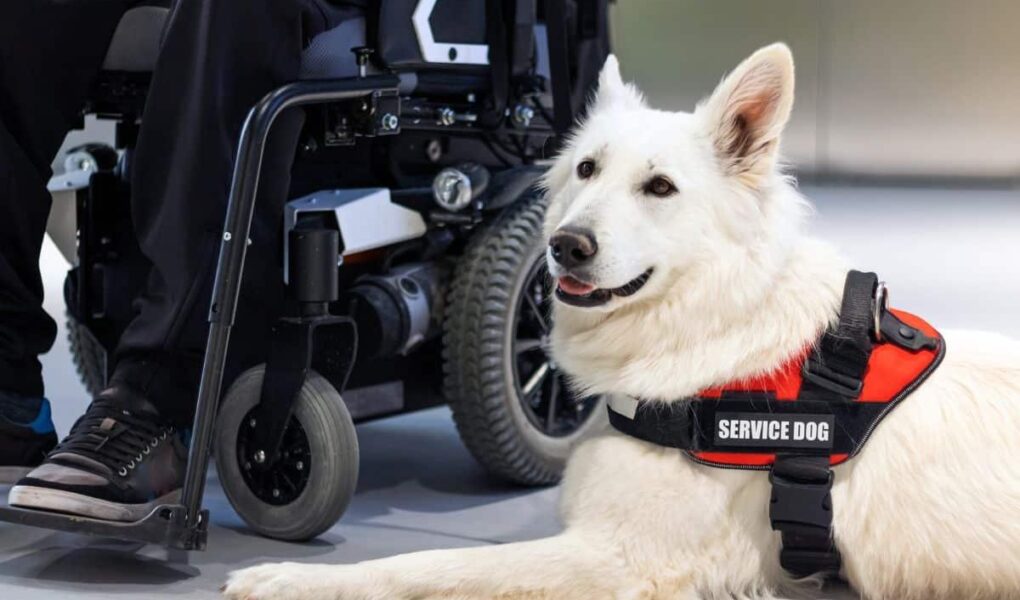Unlocking Potential: The Journey to Train Your Dog as a Service Companion
In a world where companionship takes many forms, the bond between a person and their dog can be transformative. For many individuals facing disabilities or health challenges, the idea of having a canine partner by their side is not just comforting; it can be life-changing. Service dogs are more than pets; they are meticulously trained assistants that provide crucial support, enhancing their owners’ independence and quality of life. Training your dog to become a service companion is a rewarding endeavor that goes beyond basic obedience—it’s about nurturing a unique relationship grounded in trust, communication, and purpose. Whether you have a potential service dog at home or are exploring the process, this article aims to guide you through the essential steps of training your canine companion to become the service dog you envision. Join us as we delve into the methods, responsibilities, and profound rewards of this important journey.
Table of Contents
- Understanding the Role and Responsibilities of a Service Dog
- Essential Skills and Training Techniques for Service Dogs
- Navigating Legal Requirements and Certification Processes
- Creating a Supportive Environment for Your Service Dogs Development
- Q&A
- Future Outlook
Understanding the Role and Responsibilities of a Service Dog
Service dogs are specially trained to assist individuals with disabilities, providing both physical and emotional support. Their roles extend beyond mere companionship, as they perform specific tasks tailored to the needs of their handlers. These can include but are not limited to:
- Guiding the visually impaired: Leading individuals safely through different environments.
- Alerting to medical conditions: Recognizing and alerting for low blood sugar or seizures.
- Providing stability: Assisting those with mobility challenges by offering physical support.
- Reducing anxiety: Comforting individuals with PTSD or severe anxiety during triggering situations.
Understanding these responsibilities is critical for both the handler and the dog. Training is a vital component, requiring consistency and patience. Service dogs must display desirable traits such as:
- Calmness: Remaining composed in various environments.
- Focus: Staying attentive to their handler’s needs.
- Socialization: Interacting appropriately with people and other animals.
- Obedience: Following commands reliably to perform tasks effectively.
Essential Skills and Training Techniques for Service Dogs
Training a service dog requires a blend of essential skills and tailored techniques that ensure the animal can effectively assist their handler. At the core of service dog training is basic obedience, which includes commands such as sit, stay, come, and heel. These foundational commands are critical for maintaining control in various situations. Additionally, dogs must develop task-specific skills based on their handler’s needs. This can include retrieving items, providing deep pressure therapy, or guiding individuals with mobility challenges. To streamline training, it’s beneficial to implement the following strategies:
- Positive Reinforcement: Rewarding desired behaviors with treats or praise.
- Consistency: Using the same commands and cues to avoid confusing the dog.
- Socialization: Exposing the dog to different environments to build comfort and adaptability.
Effective training often employs structured methods that cater to the individual dog’s pace and learning style. Utilizing a training schedule helps in establishing a routine that dogs can thrive in. Regular practice sessions, ideally lasting 15-20 minutes, can facilitate better retention and engagement. Here’s a simple breakdown of a training approach:
| Training Focus | Duration | Frequency |
|---|---|---|
| Basic Commands | 15 minutes | Daily |
| Task-Specific Training | 20 minutes | 3 times a week |
| Socialization Exercises | 30 minutes | Twice a week |
By building these essential skills and adhering to effective training techniques, handlers can cultivate a strong partnership with their service dogs, enhancing not only the dog’s capabilities but also the quality of life for those they assist.
Navigating Legal Requirements and Certification Processes
Training your dog to become a service dog involves understanding not just the training process but also the legal stipulations and certification requirements that govern service animals. It’s vital to recognize that in the United States, service dogs are defined under the Americans with Disabilities Act (ADA). This means that for your dog to be recognized as a service animal, it must be trained to perform specific tasks that assist you with a disability. While the law does not mandate registration or certification, many organizations offer programs that can help you navigate the process and equip you with the knowledge you need. Here are key points to consider:
- Research State Laws: Different states may have varying regulations regarding service animals.
- Task Training: Your dog must be trained to perform tasks directly related to your disability.
- Public Access: Ensure your dog can behave in public settings without disrupting others.
- Documentation: Although not legally required, having helpful documentation can ease travel and public access issues.
While you might not need formal certification to train your dog as a service animal, obtaining some form of recognition can significantly ease your experience. Numerous reputable organizations provide training programs and can guide you through the legalities. Some may also issue identification or vests to signify your dog’s status. Here’s a simplified table of commonly used training organizations:
| Organization | Focus Area | Website |
|---|---|---|
| International Association of Assistance Dog Partners | General Service Dog Training | iaadp.org |
| Service Dog Certification | Certification Services | servicedogcertification.org |
| Paws with a Cause | Training for Assistance Dogs | pawswithacause.org |
Creating a Supportive Environment for Your Service Dogs Development
Creating a nurturing atmosphere is essential for your service dog’s growth and training journey. Start by ensuring your home is a safe space where your service dog can explore and learn without distractions. Establish consistent routines that incorporate playtime, training sessions, and relaxation periods. This structured environment will help your dog understand expectations and build confidence in their surroundings. Consider implementing the following elements:
- Designated Training Areas: Use specific rooms or outdoor spaces for training to create an association with learning.
- Calming Elements: Integrate soothing sounds, like soft music, to promote relaxation during training or downtime.
- Positive Reinforcement Supplies: Keep treats and toys easily accessible to reward good behavior promptly.
Developing social skills is another crucial aspect of your dog’s training. Expose your service dog to various environments, situations, and people to enhance their adaptability and reduce anxiety. Ensure that these experiences are positive by introducing them gradually and watching for signs of discomfort. Key strategies for fostering social development include:
- Socializing with Other Dogs: Schedule playdates or visit dog parks to help your service dog learn proper interactions.
- Public Outings: Familiarize your dog with different public spaces, like grocery stores or parks, where they will eventually assist you.
- Routine Vet Visits: Regular check-ups not only maintain health but also ensure your dog remains comfortable around new people.
Q&A
Q&A: Training Your Dog to Become a Service Dog
Q1: What is a service dog?
A1: A service dog is a specially trained canine that assists individuals with disabilities in navigating daily life. These dogs are not just pets; they are partners. They can perform tasks such as guiding someone with a visual impairment, alerting a person with hearing loss, or even providing emotional support to someone with a mental health condition.
Q2: Can any dog become a service dog?
A2: While many breeds can be trained as service dogs, not every dog is suited for this role. Ideal candidates tend to be calm, focused, and sociable. Common breeds include Labrador Retrievers, Golden Retrievers, and German Shepherds, but it ultimately depends on the individual dog’s temperament and abilities.
Q3: What are the steps to train my dog as a service dog?
A3: Training a service dog involves several key steps:
- Basic Obedience: Start with fundamental commands like sit, stay, and come. A solid foundation in obedience is essential.
- Socialization: Expose your dog to various environments, people, and situations to help them remain calm and confident in public.
- Task Training: Depending on your specific needs, teach your dog tasks that assist you. This could include fetching items, providing stability, or alerting to specific sounds.
- Public Access Training: Train your dog to behave appropriately in public settings. This includes ignoring distractions and staying calm during outings.
- Certification: While not required, obtaining certification can help ease access to public places.
Q4: How long does it take to train a service dog?
A4: Training duration can vary widely based on the dog’s age, breed, and the specific tasks they need to learn. On average, it can take anywhere from 6 months to 2 years to fully train a service dog. Consistency and patience are key!
Q5: Are there legal considerations for service dogs?
A5: Yes, service dogs are protected under the Americans with Disabilities Act (ADA), allowing them access to public spaces where pets typically aren’t allowed. However, it’s essential to understand that emotional support animals and therapy dogs do not have the same legal status.
Q6: What if I need help training my dog as a service dog?
A6: If you find the training process overwhelming, consider consulting a professional dog trainer who specializes in service dog training. They can provide guidance and support tailored to your specific needs and situation.
Q7: What are the benefits of having a service dog?
A7: Service dogs can greatly enhance the quality of life for their handlers. They offer not only physical assistance but also emotional support, companionship, and increased independence. Many handlers report better mental health and a greater ability to engage with the world around them.
Q8: Can I train my dog on my own, or should I seek professional help?
A8: While some individuals successfully train their own service dogs, it’s often beneficial to work with a professional, especially for specific tasks or public access training. A skilled trainer can help you navigate challenges and ensure your dog is properly prepared for their role.
Q9: What common mistakes should I avoid while training my service dog?
A9: Some common mistakes include skipping basic obedience training, failing to socialize your dog adequately, and inconsistency in commands or training sessions. It’s crucial to have realistic expectations and to remember that patience and perseverance are vital to successful training.
Q10: How can I maintain mydog’s skills once the training is complete?
A10: Regular practice is essential for maintaining your service dog’s skills. Set aside time for refreshers on commands and tasks, continue socialization outings, and engage in activities that reinforce their training. This ensures your dog remains sharp and ready to assist whenever necessary!
By addressing these questions, you’ll be better equipped to embark on the rewarding journey of training your dog to become a dedicated service companion. Remember, patience and love are the cornerstones of this meaningful partnership!
Future Outlook
embarking on the journey to train your dog as a service animal is as rewarding as it is challenging. While it requires patience, dedication, and a solid understanding of both your dog’s capabilities and the specific needs of the individual they will assist, the benefits can be life-changing. From enhanced independence for those who require support to the unbreakable bond formed between human and canine, service dogs play an invaluable role in enhancing quality of life.
As you take your first steps towards this training, remember that every dog is unique, and every journey is different. Whether you seek professional help or choose to embark on this path together with your furry companion, celebrate each small victory along the way. With persistence and love, your dog can become a steadfast partner, not just in tasks, but in navigating life’s everyday adventures. So gather your supplies, brush up on your training techniques, and get ready to transform your beloved pet into the service dog they are destined to be. Your adventure awaits!



